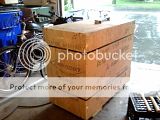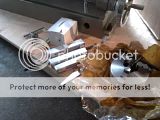(over 10000 character text limit, 10247 characters,,,)
...you may want a clamping kit (for milling). They look like this-
G1075 52 pc. Clamping Kit - 3/8" Bolt Size
but you need to know the width of the t-slots before you buy a clamping kit. On the smaller machines there's 5/16" and 3/8" slots, as well as a couple possible metric sizes.
...If you don't buy a clamping kit, then at the least you will need a piece of steel to make vise hold-down blocks from. This should be maybe 1"x1" and about a foot long. You don't need the vise to make the blocks, you just need to be able to drill a hole that is maybe 1/16" larger than the stud size you will use. So even though you'll only use about three inches of both ends for this, the whole piece of metal has to be long enough for you to hold it by hand to drill the two holes. I can explain this better if you want to know.
...if you do want a conventional mill vise, look for a 3-inch or even a 2-inch. There's a 2-inch one around that tilts and turns as well for $130, if it will fit on the machine okay-
T10058 2" Two-Way Precision Angle Vise
(-if you want a more-compact tilting-vise setup, another way is to get a bigger and a smaller screwless vise. You clamp the part in the smaller vise, and then you clamp that vise in the larger vise, at whatever angle you need-)
...You will need a bench grinder. Harbor Freight has some really cheap ones, but the grinding wheels HF sells (both with the grinders, and separately) tend to be not-very-good quality. Very unbalanced. Aluminum oxide wheel, 60-grit is usual, 80 is okay, anything else is too fine for general use.
...you will need something to dress the grinder wheel with. The grinder may come with a tool, but may not. There's pinwheels, diamonds and carbide sticks. I prefer the carbide sticks myself (Enco sells them for a few bucks each).
...the mill spindle seems to be MT3, but I'm not sure how to secure a mill bit collet in that machine... does the top cover lift up, exposing a drawbar? Littlemachineshop for one sells the MT3 collets for $14 each, and you only need a 3/8" and maybe a 1/2". (Any mill bit smaller than 3/8" usually still has a 3/8" shank)
LittleMachineShop.com - Collet, 1/2" 3MT
-notice that the above collet has a 3/8"-16 thread,,,, which is the same as common UNC 3/8" all-thread rod at the hardware store. Even if your machine uses a metric drawbar, if you can FIT the 3/8" rod through the spindle, you can make the 3/8"-16 collet work here.
...for mill bits just get a couple or three each of 1/4" and 1/2" size, HSS or cobalt but not carbide. Tungsten-carbide bits are expen$ive, plus they are damaged by uneven feed rates so they don't last long in manually-operated machines.
...You will also probably want at least one fly cutter. Some people make them but Grizzly has a set of three for like $12.
G5716 Fly Cutter Set, 1/2" Shank
They use "lathe-type" tool bits, which Grizzly sells, but are cheaper & better selection over at Enco.
...Lathe and fly-cutter tool blanks: get them at Enco. HSS works fine but cobalt is a bit harder,,,, harder to shape, but stays sharp longer. You can also get a small set of the cheap brazed carbide lathe bits, it's a good idea to have them around, but for most stuff you won't need them. The HSS and cobalt ends up being more useful, since you can grind them into whatever shapes you want.
...for clamping stuff level in the vise, you will need parallels. Forget about the normal ones, they're almost all too big for this. I have a 4-inch 'normal' vise and most of them are too big for that. Get the adjustable type, like these:
LittleMachineShop.com - Adjustable Parallel Set
...a Dremel-style tool and a diamond-plated cutoff wheel: you will (on rare occasion) need to resharpen the scribe tip, or grind chips out of carbide lathe bits. You need a diamond grinder for that. Be
very gentle when grinding carbide with this method--if you press too hard, the diamonds on the cutoff wheel heat up, they melt the brazing holding them on, and then they fly away. Also be careful not to breathe carbide grinding dust, it is very bad to inhale.
...to drill holes exactly on a center-punched mark or co-axial with an existing hole, you need a coaxial indicator. A USA/name-brand one will cost you $350-$500+, but there's a cheap China one out there for like $75 or so-
LittleMachineShop.com - Coaxial Centering Indicator
They have a video showing how its used.
There's various improvised ways of getting by without this tool, but they are all much slower, much more bother and usually not as accurate.
...Somebody mentioned a rotary table. If you get one, I'd STRONGLY suggest you get one that has Brown & Sharp-style dividing plates available. There's 4" and 6" ones that do, none of the 3-inch ones I've found do. You want to get the largest one that will fit usefully on the machine, so you'd need to know the clamping area size first. A 4-inch with dividing plates will cost you ~$150 and a 6-inch will cost ~$350.
(note that I am not totally certain these are all the exact items you need.... from the jumbled specs, it appears that the mill/drill spindle is an MT3, and the tailstock is an MT2. The lathe spindle will be threaded, but the specs were not given for that-)
All I can think of right now.... I'm up to about $600 so far, and I've left out the clamping kit, the rotary table and the tilting vise.
Astonishing, ain't it?





